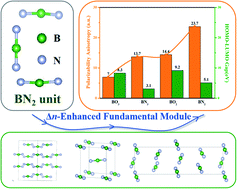Linear unit BN2: a novel birefringence-enhanced fundamental module with sp orbital hybridization†
Abstract
Inorganic planar π-conjugated groups are advantageous to generate large birefringence in optical functional materials, and many excellent materials contain CO3, BO3 or B3O6, such as CaCO3, α/β-BaB2O4 (α/β-BBO), and KBe2BO3F2 (KBBF). In view of their microscopic structures, the common characteristics are the planar structures, which are regarded as birefringence-enhanced fundamental modules (FMs). Nowadays, exploring novel birefringence-enhanced FMs is becoming a burning issue. Herein, we investigated the birefringence-enhanced FMs in B–N systems and found that the BN2 linear unit could produce great birefringence. Through the investigation based on the Inorganic Crystal Structure Database, some compounds with the BN2 linear group were screened out with the formulas A3BN2 (A = Li, Na), A3BN3 (A = Mg, Ca), and Ba3(BN2)2. Particularly, Ca3(BN2)N exhibits a great birefringence of about 0.411 at 1064 nm, which is 3.5, 2.5 and 2.0 times those of the most commercially used birefringent crystals α-BaB2O4 (Δn = 0.116 at 1064 nm), CaCO3 (Δn = 0.164 at 1064 nm) and YVO4 (Δn = 0.208 at 1064 nm), respectively. To find the origins of the optical properties of compounds with the BN2 linear group, the first-principles, REDA and polarizability anisotropy analysis methods were used. Owing to the structural arrangement and the polarization anisotropy of the BN2 linear group, it can influence the birefringence significantly. This work will provide a general way for exploring birefringence-enhanced FMs in B–N compounds.



 Please wait while we load your content...
Please wait while we load your content...